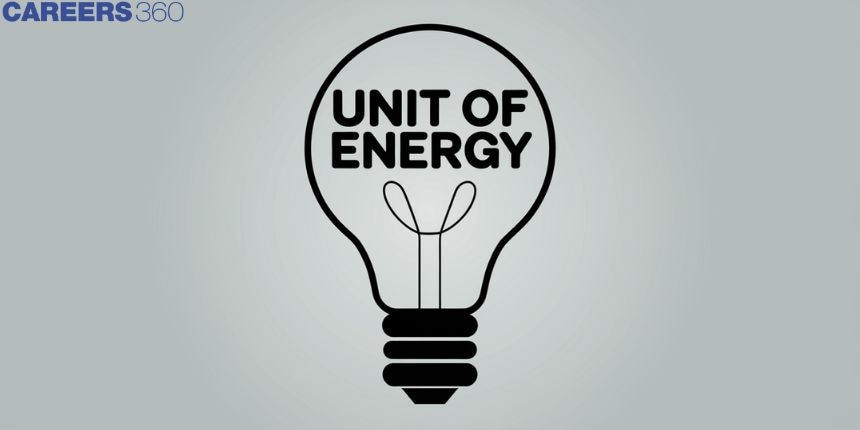Unit of Energy -SI Unit, CGS, Conversion, FAQs
What is unit of energy?
The Si unit is of energy/work is the joule (J), which was named after English physicist James Prescott Joule (1818-1889). The work done by a force of one newton moving an object one meter (J = N m) is one joule.
Energy:-
In physics, energy is the ability to perform work. It can take many many forms, including potential, kinetic, thermal, electrical, chemical, radioactive, and others.
Energy= force*distance
CGS unit of energy:-
The unit table of the CGS system is as follows:
“erg”
The erg is a unit of energy equal to 10^(-7) J. An erg is the amount of work performed by a single dyne over a one-centimeter distance.
Also read -
- NCERT Solutions for Class 11 Physics
- NCERT Solutions for Class 12 Physics
- NCERT Solutions for All Subjects
JEE Main/NEET 2027: Physics Important Formulas for Class 10
NEET 2025: Mock Test Series | Syllabus | High Scoring Topics | PYQs
JEE Main: Study Materials | High Scoring Topics | Preparation Guide
JEE Main: Syllabus | Sample Papers | Mock Tests | PYQs
- What is unit of energy?
- Energy is measured in:-
- KWH to unit conversion :-

Commercial unit of energy:-
Kilowatt-hour is the commercial unit of energy.
The Si unit is of energy becomes little when huge amounts of energy need to be expressed.
Energy is measured in:-
Energy is a complicated topic since, depending on the application, there are several different ways to measure it. Electrical, mechanical, chemical, thermal, and nuclear energy are examples of different types of energy.
- Unit of thermal energy measured-
Thermal energy refers to the temperature differences between objects as well as the heat produced when energy is converted from one form to another. The energy content of fuel is measured in British Thermal Units (BTU or Btu) on a greater scale.
- Electric energy measured-
The attraction and repulsion of charged particles is the basis for electrical energy. Voltage is created by the intensity of the charge and the distance between particles.
A kilowatt-hour is a unit of measurement for transformed energy.
1000watts= 1 kilowatts (measuring power)
Watt hour is unit of:-
A watt-hour (Wh) is an energy unit that is used to calculate the amount of work done or generated. Household appliances and other electrical gadgets conduct "work," which necessitates the usage of electricity as a source of energy.
Related Topics Link, |
KWH unit :-
The kilowatt-hour (SI symbol: kWh or kW h; frequently written as kWh) is an energy unit that equals 3600 kilojoules (3.6 megajoules).Electric utilities often utilise the kilowatt-hour as a billing unit for energy delivered to customers.
Unit of measurement: kWh or kWh is the symbol for energy.
KWH to unit conversion :-
How to convert watts to kilowatts (kW)?
0.6 kW = 600 W
kilowatts multiplied by daily usage-
1.2 kWh = 0.6 kW x 2 hours
30 days multiplied by daily use (one month)-
36 kWh/month = 1.2 kWh x 30 days
How many units in KWH?
1000 Watt-Hour = 1 Kilowatt-Hour (kWh) = 1 unit (on your meter).
Also Read:
- NCERT solutions for Class 11 Physics Chapter 6 Work, Energy and Power
- NCERT Exemplar Class 11 Physics Solutions Chapter 6 Work, Energy and Power
- NCERT notes Class 11 Physics Chapter 6 Work, Energy and Power
Units of energy list
Energy units can be preceded by a variety of elements, and different units are typically used to measure energy. The following are some examples of common units:
- Thermal unit of the United Kingdom (BTU)
- Kilowatt-hour Horsepower (kWh)
- Electron volts per Calorie (eV)
- Hartree is a character in the novel Hartree (the atomic unit of energy)
- Units of Rydberg
- An oil barrel
Also check-
- NCERT Exemplar Class 11th Physics Solutions
- NCERT Exemplar Class 12th Physics Solutions
- NCERT Exemplar Solutions for All Subjects
NCERT Physics Notes:
Frequently Asked Questions (FAQs)
Power and energy are related in that power has units of energy that are split by time.
Watts is the unit of power.
Joules unit are a unit of energy.
(1 Joule/1 second) Equals 1 Watt
The commercial unit of energy is the kilowatt-hour (kWh). The quantity of energy utilised by a device in one working hour at a constant rate of one kilowatt is defined as one kilowatt-hour.
The Joule is the Si unit is of energy.
As a result, 1 kWh = 1kW x 1h = 1000W x 1h = 1000(J/s) x 3600 s = 3.6 x106 J is the link between commercial and Si unit iss of energy.
One joule equals 10^7 ergs.
When the units of force and length are doubled, the unit of unit energy grows fourfold.
The following is the relationship between energy, force, and distance:
Force multiplied by distance equals energy.
N and m are the units of force and distance, respectively.
As a result, E = N x m
As a result, E = 2 N x 2 m
As a result, E = 4Nm.
3.6*10^6 Joules equals one unit of electrical energy.
Also Read
02 Jul'25 07:47 PM
02 Jul'25 07:29 PM
02 Jul'25 07:29 PM
02 Jul'25 05:42 PM
02 Jul'25 05:34 PM
02 Jul'25 05:09 PM
02 Jul'25 05:08 PM
02 Jul'25 05:01 PM
02 Jul'25 04:59 PM
02 Jul'25 04:58 PM

